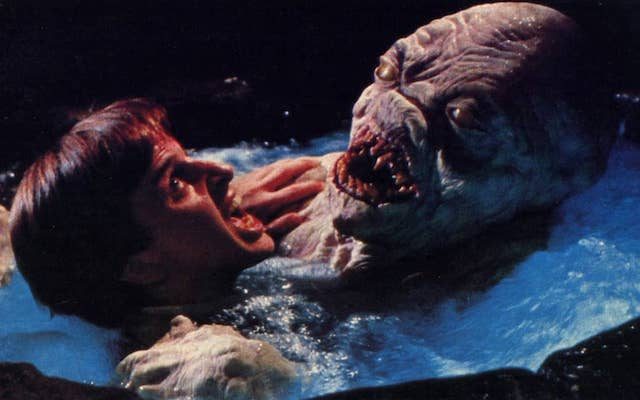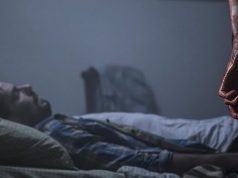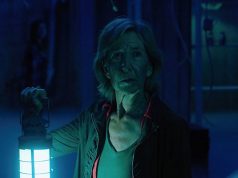
When I say “cinema’s scariest haunted house,” what do you think of? No, not that one. Not that one either. Try again. Yes, the Amityville house! That’s right! The Long Island home where a man killed his family (in real life) and where spooky things subsequently happened (allegedly in real life [but come on]) has been the inspiration for a whole junk-drawer full of domicile-based horror films. These include the original Amityville Horror, a remake, a couple of theatrical sequels, some straight-to-video sequels, and a few sequels that were released directly into a dumpster in Burbank.
Actually, most of them aren’t even “sequels” but freestanding, unrelated episodes that take place in, or feature haunted artifacts removed from, the Amityville house, which can be destroyed in one movie and appear again in the next, like Wile E. Coyote. One of these non-sequels, the third one, was in 3D, because it was back in the days when part threes always had to be in 3D.
As the film begins, the murder house has become a lair for con artists who hold fake seances to scare gullible people out of their money. Along comes John Baxter (Tony Roberts), a smug investigative journalist who’s eager to prove that the stories about the house being haunted are poppycock, maybe even balderdash. Despite the apprehensions of his skittish assistant, Melanie (Candy Clark), Baxter buys the place and moves in, ignoring the conventional wisdom that “to prove a point” is a bad reason for homeownership.
The only overtly unusual thing about the house is that there’s a deep pit in the basement. The Realtor says it’s an old dry well, but it’s most likely a hell-mouth through which demons can pass from the infernal realm into ours. It’s covered up with some boards, though, so it’s probably okay.
Baxter hasn’t lived in the house a day when the Realtor comes by for some paperwork, finds no one home, lets himself in, and wanders up to the attic, where a swarm of flies attacks him in what the movie erroneously believes is a horrifying manner. Really, the flies just buzz around his face, the way flies do. And he stands there and takes it, like he’s powerless to run away from flies. Then the flies kill him, somehow, I guess. I don’t know how a swarm of houseflies kills a guy, but he’s dead when it’s over, and the flies were the last ones to see him alive, so there you go. Maybe one of the flies had a gun?
Melanie is spooked by the incident — Melanie is spooked by everything, actually, calling into question her suitability as an assistant to someone who debunks supernatural phenomena — while Baxter remains condescendingly certain that there’s nothing unusual going on, no matter how obvious it gets that there is. When Baxter is nearly killed by a mysteriously malfunctioning elevator in his office building, while Melanie is chased out of the Amityville house by a blast of cold air from the basement hell-mouth, they both become more entrenched in their already-held positions, like when Bill O’Reilly talks to Jon Stewart. Baxter is more confident than ever that there’s no such thing as ghosts, and Melanie graduates to wide-eyed, trouser-soiling hysteria.
Given his pigheadedness, it will not surprise you to learn that Baxter has an ex-wife who hates him. She doesn’t want their daughter, Susan (Lori Loughlin), staying with him in his haunted house, but Baxter cleverly circumvents this decree by ignoring it. Susan isn’t afraid of the house anyway, and neither is her rebellious best friend, who is played by a young Meg Ryan in her original face. The girls and two of their boy friends hold a giggly seance in the attic, only instead of a real Ouija board they use scraps of paper with letters written on them, like the pioneer children did. As homemade occult tools go, it’s cute.
The film has some strange ideas about what’s scary. Baxter is alone in the house one night when he hears the upstairs bathroom sink running. He goes upstairs, turns the water off, and returns to his business. Now, on the one hand, running water isn’t scary. If the worst thing that happens to you in a murder house is that the faucets sometimes turn themselves on, consider yourself lucky. But on the other hand, Baxter is so stubborn about denying the supernatural that he won’t admit even privately that a self-operating faucet, while not “scary” per se, is at least eerie.
Finally, after a hundred other not-scary-but-kind-of-strange events, plus a couple deaths, Baxter lets a team of paranormal experts come to the house with their spectrometers and ghost microphones and whatnot. The team’s leader, a wormy man named Eliot (Robert Joy), gazes into the basement hell-mouth and harasses the demon that the movie forgot to tell us was behind all this into coming out, whereupon it kills him — so thanks for your help, Eliot. Either because of this or in spite of it (cause and effect aren’t really the movie’s forte), the house starts to collapse and explode, and only a handful of people escape. One of them is Baxter, who’s such a jackass that I bet even now he won’t admit the house was possessed. Oh, well. See you in the next episode, cinema’s fifth or sixth scariest haunted house!
— GeekNation





